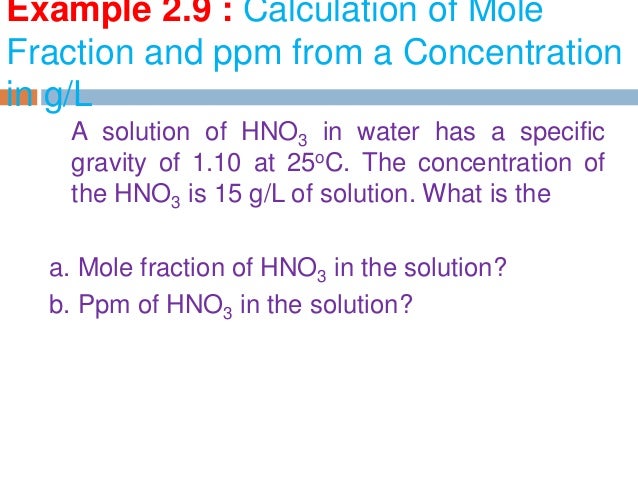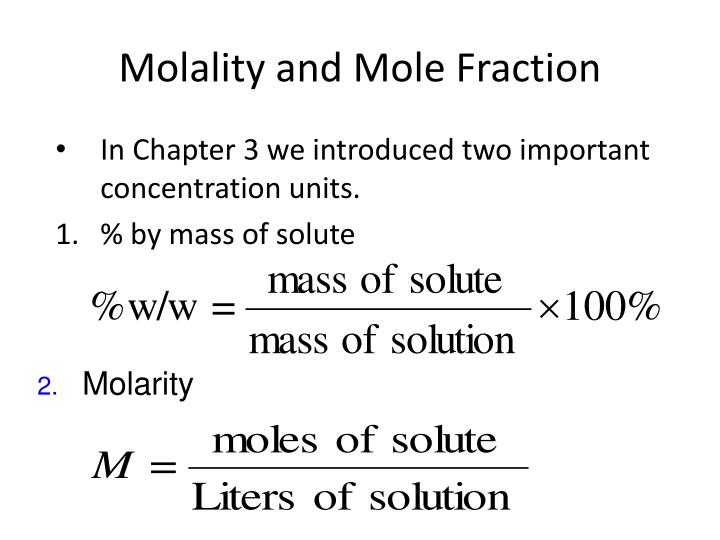
Of moles of that component present in the solution to the total number of molesĬonsider a binary solution components solvent (A) and solute (B). PPM means 'parts per million,' so to calculate it you divide the amount of the solute by the total amount of solution, them multiply by 106.

The Relation Between Mole Fraction and Molality:įraction of any component of a solution is defined as the ratio of the number The formality of a solution may be defined as a number of moles of ionic solute o is the number of moles of solute dissolved in one liter of. Ionic compound is called formole and its molarity is called formality. Calculate concentration in terms of molarity, ppm and percent composition (4.1b). This concept is used in the case of ionic substances. PPM means 'parts per million,' so to calculate it you divide the amount of the solute by the total amount of solution, them multiply by 106. The formality of a solution depends on temperature. You can perform a PPM conversion easily provided you have two quantities in the same unit (or that you can convert into the same unit) or a percentage value. Calculate the molarity of mercury (Hg) at a concentration of 1 ppm in water. Parts per Million (ppm) Mole Fraction Mol/kilomole mg/m3 Mole (volume) Notes: MW H2S kg/kgmole 1 mg H2S m3 at 101.325 kPa and 15 C To convert H2S concentration from one set of units to another simply put the known concentration in the yellow cell of the column that corresponds to the units (i.e., mole ) and read the conversion in the row. Answer: Mole fraction of NaCl is 0.018 and the mole fraction of water is 0.982. Calculate the mole fraction of both components of a mixture of water (H2O). The final answers would be the same, but the numbers in the calculations would be different. We could have used any paring of numbers that gives a mole fraction of 0.5. Using 0.5 and 1 is the simplest meaning of a mole fraction of 0.5. Calculate the mole fraction of NaCl and H 2 O, if 0.010 moles of NaCl is dissolved in 100 grams of pure water. Comment: A mole fraction of 0.50 could mean 1.0 mol of one component in 2.0 total moles. If the formula mass of solute is equal to its molar mass, then the formality is equal to molarity. In the case of an ideal gas mixture, the mole fraction is represented by the ratio of partial pressure to total pressure of the mixture. The number of formula mass in gram present per litre of a solution. And also we have a mole calculator you can visit and know the difference between a mole and mole fraction.A solution having normality equal to unity is called a normal solution.Įquivalent mass = strength of solution in g/L. Solution Mole Fraction = Moles of solute / (Moles of solute + Moles of solvent) Mole Fraction = 15 / (15 + 30) = 0.333 mole Calculator useĪ Mole Fraction calculator is used to find the concentration with help of solute and solvent. Given data solute = 15 mole solvent = 30 mole If we have a solute 15 mole and solvent is 30 mole then calculate the mole fraction. ppm of dissolved O2 and you are asked to calculate the number of moles of. It has only one disadvantage that it is not convenient for a liquid solution. a) volume b) mass c) mass/volume d) mole fraction e) mole percent f). The Mole Fraction case is like an ideal gas mixture.For the calculation of the mole fraction, we don't need to find information about the density phase.Mole Fraction does not depend on temperature.

Using Raoults Law to convert mole fraction to partial pressure. Also, when analyzing the solutions chemist use mole formula to measure the concentration of components.

Mole fraction is equal to the number of a component’s moles divided by the total number of a solution’s moles. It is a formula in the field of physics that is unitless expression. To calculate the mole fraction we have a formula given below: Mole Fraction = Moles of solute / (Moles of solute + Moles of solvent) Mole Fraction AdvantagesĪdvantages of mole fraction are given below: Converting parts per billion by volume to micrograms per cubic meter (ADEQ, 2008a). Mole fraction refers to a unit of concentration. The symbol used for this is the lower-case Greek letter chi, χ.

Mole fraction is a unit of concentration, defined to be equal to the number of moles of a component divided by the total number of moles of a solution. To find the Mole fraction we can divide the moles of one component by the total number of moles in a mixture. Parts per million (ppm) is the number of units of mass of a contaminant per million units of total mass.


 0 kommentar(er)
0 kommentar(er)
